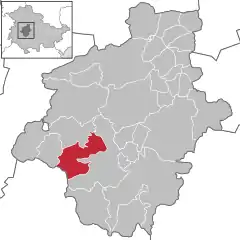Friedrichroda
Friedrichroda is a town in the district of Gotha, Thuringia, Germany. It is situated at the north foot of the Thuringian Forest, 21 km by rail southwest of the town of Gotha. It is surrounded by fir-clad hills and possesses numerous handsome villa residences, a Kurhaus and a sanatorium. In the immediate neighborhood is the beautiful ducal hunting seat of Reinhardsbrunn, built out of the ruins of the famous Benedictine monastery founded in 1085. On 1 December 2007, the former municipalities Ernstroda and Finsterbergen were incorporated by Friedrichroda.
Friedrichroda | |
|---|---|
 Main street | |
 Coat of arms | |
Location of Friedrichroda within Gotha district  | |
 Friedrichroda  Friedrichroda | |
| Coordinates: 50°52′0″N 10°34′0″E | |
| Country | Germany |
| State | Thuringia |
| District | Gotha |
| Government | |
| • Mayor | Thomas Klöppel (SPD) |
| Area | |
| • Total | 36.91 km2 (14.25 sq mi) |
| Elevation | 430 m (1,410 ft) |
| Population (2019-12-31)[1] | |
| • Total | 7,195 |
| • Density | 190/km2 (500/sq mi) |
| Time zone | UTC+01:00 (CET) |
| • Summer (DST) | UTC+02:00 (CEST) |
| Postal codes | 99892–99894 |
| Dialling codes | 03623 |
| Vehicle registration | GTH |
| Website | www.friedrichroda.de |
History
Within the German Empire (1871–1918), Friedrichroda was part of the Duchy of Saxe-Coburg and Gotha.
Development of first jet flying wing aircraft
During the late years of World War II, Friedrichroda was the site of manufacture of the mock-up production of the double-seat, all-weather fighter version of the Horten Ho 229 V4 and V5 (Versions 4 and 5) flying wing jet aircraft. The only surviving example of the Horten jet is the Horten Ho 229 V3. In December 2011, the Horten V3 was transferred to the Smithsonian Institution's Paul E. Garber Restoration Facility in Suitland, MD.
Gallery
 Friedrichroda "Blasius" church
Friedrichroda "Blasius" church Stone head
Stone head Memorial for victims of an air raid in Friedrichroda
Memorial for victims of an air raid in Friedrichroda
Personalities
Sons and daughters of the city
- Christian Friedrich Ludwig Buschmann (1805–1864), musical instrument maker (Terpodion, Harmonium)
- Johann Georg Eccarius (1818–1889), worker activist and trade unionist
- Anna-Maria Müller (1949–2009), luger
- Ilona Brand (born 1958 as Ilona Oeckel), luger
- Katrin Göring-Eckardt (born 1966 as Katrin Dagmar Eckardt), politician (The Greens) and Vice Bundestag president 2005–2013
- Karsten Albert (born 1968), luger
- Ralph Gebstedt (born 1971), ski jumper
- Judith Augoustides (born 1975 as Judith Deister), beach volleyball player
- Marko Baacke (born 1980), Nordic combiner
- Philipp Klewin (born 1993), footballer
Other personalities

- Auguste Schmidt (1833–1902), teacher and writer
- Helene Lange (1848–1930), teacher and pioneer of women's education
- Käte Duncker (1871–1953), politician, women's lawyer, visited the Higher School of Daughters
- Melitta Sollmann (born 1958), luger
- Sandra Hüller (born 1978), actress, grew up in Friedrichroda
- Tatjana Hüfner (born 1983), luger, Olympic champion in the single-seater
- Marion Thees (born 1984), skeleton pilot
See also
References
- "Bevölkerung der Gemeinden, erfüllenden Gemeinden und Verwaltungsgemeinschaften in Thüringen Gebietsstand: 31.12.2019". Thüringer Landesamt für Statistik (in German). August 2020.
- Chisholm, Hugh, ed. (1911). . Encyclopædia Britannica (11th ed.). Cambridge University Press.
External links
 Media related to Friedrichroda at Wikimedia Commons
Media related to Friedrichroda at Wikimedia Commons